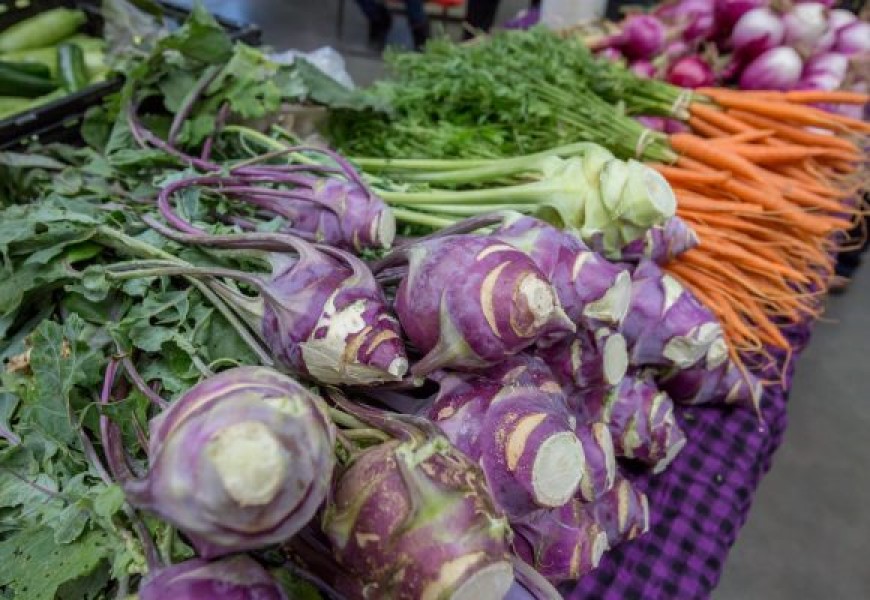Kohlrabi

What is Kohlrabi?
Kohlrabi is a low, stout cultivar of wild cabbage. It is the same species as cabbage, broccoli, cauliflower, kale, Brussels sprouts, collard greens, savoy, and gai lan.
Kohlrabi is an important part of the Kashmiri cuisine. It is prepared with its leaves and served with a light soup and eaten with rice. In Cyprus it is popularly sprinkled with salt and lemon and served as an appetizer.
Nutrition
Kohlrabi is highly valued around the world not only for its diversity in cooking applications, but also because it is full of nutrients and minerals like copper, potassium, manganese, iron, and calcium, as well as vitamins, such as vitamin C, B-complex vitamins, vitamin A, and vitamin K. Along with that, kohlrabi is also high in dietary fiber and antioxidant compounds, such as phytochemicals and various carotenes.
The fiber aids in digestion. It is very low in calories so can aid in weight loss. The potassium makes kohlrabi an energy booster and helps cardiovascular health and blood pressure. The iron helps prevent anemia. The carotenes mean kohlrabi is good for the eyes.
How to Choose and Prepare
It can be eaten raw or cooked, using both the stem and the leaves. The taste and texture of kohlrabi are similar to those of a broccoli stem or cabbage heart, but milder and sweeter, with a higher ratio of flesh to skin. The young stem in particular can be as crisp and juicy as an apple, although much less sweet. When eaten raw, kohlrabi has a faint, mild, peppery bite that you might associate with a radish.
Kohlrabi stems (the enlarged vegetal part) are surrounded by two distinct fibrous layers that do not soften appreciably when cooked. These layers are generally peeled away prior to cooking or serving raw, with the result that the stems often provide a smaller amount of food than one might assume from their intact appearance.
The bulbous kohlrabi stem is frequently used raw in salad or slaws. It has a texture similar to that of a broccoli stem, but with a flavor that is sweeter and less vegetal. Bigger isn’t always better, and that’s certainly true with kohlrabi. When buying kohlrabi, go for ones that are about three inches in diameter or less. Not only will you be rewarded with a more flavorful vegetable, but it will have thinner skin that won’t necessarily need to be peeled. Larger bulbs tend to lack in flavor and may have woody sections on the inside. Kohlrabi leaves are edible and can be used interchangeably with collard greens and kale. Younger greens can be eaten raw in salads, while more mature, larger greens benefit from a quick sauté or steam.
You can find kohlrabi at La Otra Banda, Green Tractor Farm, and many other Market vendors.
How to Store
Cut off leaves, wrap them in a damp paper towel, and place in a plastic bag. Leaves can be refrigerated for three to four days; the bulb for several weeks.
Kohlrabi Recipes
- Asian Noodle Soup with Winter Vegetables and Tofu
- Chili-Dusted Kohlrabi Fries
- Kohlrabi and Carrot Slaw
- Kohlrabi and Cabbage Salad with Maple Lemon Dressing
- Kohlrabi Gratin by Romero Farms
- Kohlrabi Risotto
- Kohlrabi Salad with Cilantro and Lime
- Lillet and Brown-Butter Glazed Radishes with Kohlrabi
- Mashed Cauliflower and Kohlrabi
- Potato, Corn, and Kohlrabi Chowder
- Raw Root Bowls with Zesty Orange Dressing
- Roasted Kohlrabi with Parmesan
- Sauteed Kohlrabi with Onions and Cream
- Vegan Cream of Kohlrabi Soup
Note
Info gleaned from Wikipedia, The Kitchn, and Organic Facts.
This locally inspired recipe is brought to you by Pam Walker. Pam is an avid home cook, writer, and local farm and food activist who is also a board member of the Santa Fe Farmers’ Market Institute. Thank you, Pam, for helping inspire us to use locally sourced ingredients!






